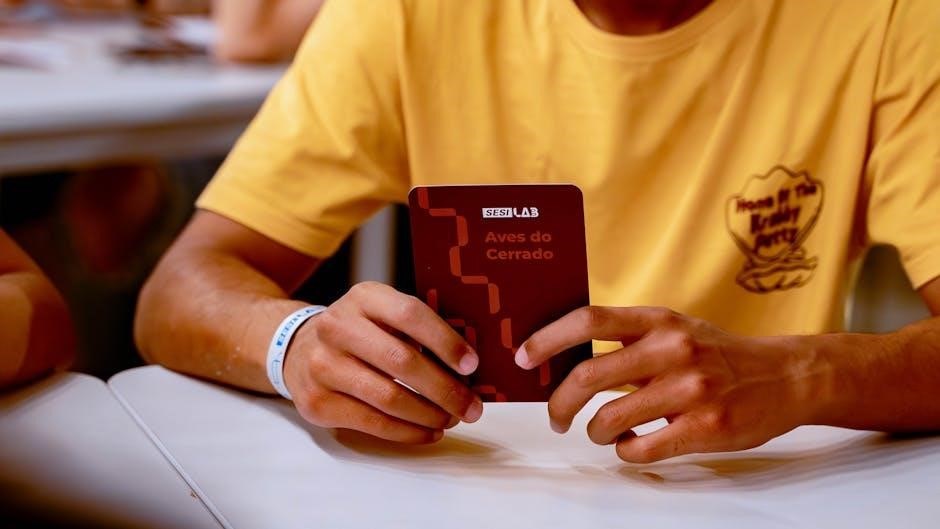The Pokémon Trading Card Game (TCG) is a popular collectible card game introduced in 1996. Players use decks featuring various Pokémon, Energy, and Trainer cards to battle. It combines strategic gameplay with collectible elements, appealing to both competitive players and enthusiasts. The TCG has grown into a global phenomenon, offering a unique way to engage with the Pokémon universe.
What Are Pokémon Cards?
Pokémon cards are collectible cards featuring various Pokémon, Energy, and Trainer characters. Each card has unique artwork, stats, and gameplay effects. They come in different rarities, such as Common, Uncommon, Rare, and holographic cards. Basic cards include Pokémon that can be played directly, while Stage cards evolve from them. Energy cards power attacks, and Trainer cards provide special abilities. These cards are used to build decks for competitive play or collected for their artistic and nostalgic value. They are central to the Pokémon TCG experience, offering both strategic gameplay and a fun collecting adventure.
Why Collect and Play Pokémon TCG?
Collecting and playing the Pokémon TCG offers a thrilling combination of strategy, creativity, and community engagement. Players enjoy building unique decks, mastering evolving strategies, and competing in organized events. Collectors appreciate the vibrant artwork, rarity of certain cards, and the nostalgia tied to iconic Pokémon. The game fosters social interaction through trading cards and sharing tips. Whether for fun or competition, the Pokémon TCG provides endless entertainment and a sense of achievement, making it a beloved hobby for fans of all ages.

Getting Started with Pokémon TCG
Start with a starter deck to learn basic rules and card types. Begin by understanding simple strategies and building a foundational collection. Expand gradually.
Understanding the Basic Rules
The objective of the Pokémon TCG is to reduce your opponent’s Pokémon’s HP to zero. Players take turns drawing cards, playing Pokémon, attaching Energy, and using attacks. A standard deck contains 60 cards, including Pokémon, Energy, and Trainer cards. Each turn, you can play one Basic Pokémon and attach one Energy card. Attacks require specific Energy types, and effects from Trainer or Stadium cards can influence gameplay. The game ends when one player’s Pokémon are all knocked out or unable to play.
What You Need to Begin Collecting
To start collecting Pokémon cards, you’ll need a few essential items. A starter deck or booster pack is the best way to begin, providing a foundation of basic cards. You’ll also need a deck box or album to store and organize your collection. Sleeves are crucial for protecting your cards during play and handling. Additionally, a rulebook or guide will help you understand the game mechanics. Optional accessories like card mats and deck builders can enhance your experience as you grow your collection and start building decks.

How to Collect Pokémon Cards
Start by purchasing booster packs or starter decks to build your foundation. Organize cards using binders or albums for easy access and protection. Use sleeves to preserve condition and enhance handling. Research card rarity and value to identify key additions. Trade with fellow collectors to complete sets. Set collecting goals to stay focused and enjoy the journey of building your unique collection;
Where to Buy Pokémon Cards
Pokémon cards can be purchased from various retailers, both online and in-store. Official Pokémon Centers and major retailers like Walmart, Target, and GameStop carry a wide selection. Online marketplaces such as Amazon, eBay, and card-specific shops like TCGplayer offer convenience. Local card shops often host events and carry new releases. Additionally, community forums and social media groups connect buyers and sellers. Always ensure authenticity by purchasing from reputable sources. Booster packs, starter decks, and single cards are available depending on your needs.
Understanding Card Rarity and Value
Pokémon cards vary in rarity, indicated by symbols on the bottom right corner: circles for common, diamonds for uncommon, and stars for rare. Holographic and “full art” cards are highly sought after. The value of cards depends on their condition, rarity, and demand. Cards like “Charizard” and “Pikachu” can be extremely valuable due to their popularity. Booster packs often contain a mix of rare and common cards. Grading services like PSA and Beckett can authenticate and grade cards, enhancing their value for collectors and sellers. Understanding rarity and condition helps in making informed purchasing decisions.

Building Your First Deck
A well-balanced deck typically includes 60 cards, mixing Pokémon, Energy, and Trainer cards. Focus on a few powerful cards and ensure your deck aligns with your strategy.
Choosing the Right Deck Type
When building your first deck, it’s essential to choose a type that suits your playstyle. Popular options include Standard, Expanded, and Theme decks. Standard decks use recent cards, while Expanded offers more variety. Theme decks are pre-built and great for beginners. Consider focusing on a single Pokémon type, like Fire or Water, for consistency. Starter decks often include staple cards to help you begin. Ultimately, your deck should reflect your strategy and the Pokémon you enjoy playing with. Experiment with different types to find what works best for you.
Essential Cards for Beginners
Starter decks provide a solid foundation, often including foundational cards like Basic Pokémon, Energy cards, and essential Trainers. Basic Energy cards are crucial for attacking, while Trainers like Professor’s Research or Poké Ball help manage your hand. Include a mix of low-level Pokémon with simple attacks to ease into battles. Evolution cards allow you to upgrade your Pokémon mid-game, enhancing their power. Focus on cards with clear, straightforward effects to avoid complexity. Building a balanced deck with these essentials ensures a smooth start to your Pokémon TCG journey.

Advanced Strategies for Experienced Players
Mastering Evolution cards, optimizing Energy and Trainer card usage, and leveraging Stadium effects can elevate gameplay. Experienced players refine deck builds, anticipating opponents’ moves for strategic advantages.
Mastering Evolution and Stage Cards
Evolution cards allow Basic Pokémon to transform into more powerful Stage 1 and Stage 2 forms during gameplay. These cards enhance stats and abilities, offering strategic advantages. To evolve, place a Stage 1 card on a Basic Pokémon, retaining damage and Energy. Timing evolutions is crucial, as premature upgrades can waste opportunities. Experienced players balance evolution with resource management, ensuring optimal deck synergy. Stage cards also introduce unique effects, adding depth to gameplay. Mastering these dynamics is key to advancing in competitive play and building formidable decks.
Using Energy, Trainer, and Stadium Cards Effectively
Energy cards are essential for attacking, with specific types required for certain Pokémon. Trainer cards provide strategic advantages, like drawing cards or disrupting opponents. Stadium cards affect all players, altering rules or boosting effects. Timing their use is critical; for example, using a Stadium card early can set the game’s tone. Balancing Energy attachment with Trainer and Stadium card plays enhances deck performance. Experienced players optimize these cards to control tempo and adapt to opponents’ moves, making them indispensable in advanced strategies.
Grading and Maintaining Your Collection
Grading Pokémon cards involves evaluating condition, with terms like Mint, Near Mint, and Played. Proper handling and storage in protective sleeves and binders preserve their value and quality.
How to Grade Your Pokémon Cards
Grading Pokémon cards involves evaluating their condition, with grades like Mint, Near Mint, and Played. Mint cards have no flaws, while Played cards show noticeable wear. Factors like corner wear, edge chipping, and surface scratches are assessed. Cards are graded on a scale, affecting their collectibility and value. Professional grading services, such as PSA or Beckett, provide authentication and sealed grades, enhancing credibility for collectors and sellers. Accurate grading ensures fair trading and maintains the integrity of your collection.
Proper Storage and Handling Techniques
Properly storing and handling Pokémon cards is crucial to maintaining their condition and value. Use sleeves or top-loaders for individual cards and store them in binders or hard plastic storage boxes. Avoid touching the card surface, as oils from skin can damage it. Handle cards by the edges, and keep them away from direct sunlight and moisture. For long-term storage, consider using acid-free materials to prevent degradation. Regularly clean and inspect your storage materials to ensure optimal preservation of your collection.
Resources for Further Learning
Explore official Pokémon TCG guides, tutorials, and online communities for in-depth strategies and updates. Visit Game8 and BlueStacks for detailed deck builds and tips.
Official Pokémon TCG Guides and Tutorials
The Pokémon Company provides comprehensive guides and tutorials to help players master the game. Official resources include rulebooks, video tutorials, and strategy guides. These materials cover basic rules, advanced tactics, and deck-building tips. Visit the official Pokémon TCG website for downloadable guides and interactive lessons. Additionally, platforms like Game8 and BlueStacks offer detailed tutorials and deck builds tailored for beginners and experienced players alike. These resources ensure players stay updated on the latest card sets and competitive strategies.
Online Communities and Forums
Online communities and forums are vibrant hubs for Pokémon TCG enthusiasts. Platforms like Reddit, Discord, and Facebook groups connect players worldwide. These spaces offer trading opportunities, deck-building advice, and strategies. Fans share tips, discuss card values, and participate in giveaways. Communities like Game8 and BlueStacks provide detailed guides and event updates. Engaging with these forums can enhance your gameplay and help you stay updated on the latest trends and expansions, fostering a sense of camaraderie among players of all skill levels.